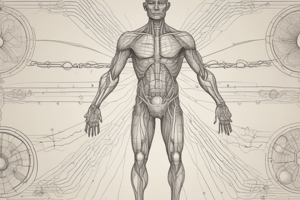Podcast
Questions and Answers
Changes to an organism's internal environment are monitored by what?
Changes to an organism's internal environment are monitored by what?
Receptors
To maintain control systems to maintain homeostasis are: 1. _________ controls, 2. _________ controls.
To maintain control systems to maintain homeostasis are: 1. _________ controls, 2. _________ controls.
- Intrinsic, 2. Extrinsic
Homeostasis control systems must be able to do what?
Homeostasis control systems must be able to do what?
Detect and resist change
What is a homeostatic control system?
What is a homeostatic control system?
To maintain homeostasis, the control system must be able to:
To maintain homeostasis, the control system must be able to:
What are intrinsic controls?
What are intrinsic controls?
Which two systems take charge in extrinsic controls?
Which two systems take charge in extrinsic controls?
What does feedback refer to?
What does feedback refer to?
What is feedforward?
What is feedforward?
Give an example of negative feedback.
Give an example of negative feedback.
What is a controlled variable?
What is a controlled variable?
What is the role of the sensor in a feedback system?
What is the role of the sensor in a feedback system?
What is the set point in a control system?
What is the set point in a control system?
What happens if the body temperature falls below the set point?
What happens if the body temperature falls below the set point?
What is positive feedback?
What is positive feedback?
What hormone is involved in positive feedback during childbirth?
What hormone is involved in positive feedback during childbirth?
When does the body use a feedforward mechanism?
When does the body use a feedforward mechanism?
What can result from disruptions in homeostasis?
What can result from disruptions in homeostasis?
What is pathophysiology?
What is pathophysiology?
Flashcards are hidden until you start studying
Study Notes
Homeostatic Control Systems Overview
- Homeostasis refers to the mechanisms that maintain a stable internal environment despite changes.
- Changes in an organism's internal environment are monitored by receptors triggering control systems.
Types of Control Systems
- Intrinsic controls: Operate within an organ to maintain homeostasis; they are built into the organ itself.
- Extrinsic controls: Initiated outside the organ, primarily regulated by the nervous and endocrine systems.
Functions of Homeostatic Control Systems
- Must detect deviations from normalcy in internal environmental factors.
- Integrate information from various sources to assess information.
- Make appropriate adjustments to restore parameters to desired values.
Components of a Homeostatic Control System
- A functionally interconnected network of body components maintains internal factors around optimal levels.
Feedback Mechanisms
- Feedback involves responses made after a change is detected to maintain stability.
- Negative feedback opposes initial changes to restore balance, while positive feedback amplifies changes in the same direction.
Negative Feedback Explained
- Commonly regulates factors like temperature, where a change triggers responses to return conditions toward normal.
- Essential for maintaining homeostasis and preventing overshoot of desired levels.
Positive Feedback and Its Role
- Amplifies initial changes; important in processes like childbirth where the hormone oxytocin intensifies uterine contractions until birth.
- Can lead to detrimental effects, like in heatstroke, when regulatory mechanisms fail.
Feedforward Mechanisms
- Anticipatory responses that occur before a change is detected to prevent disruptions in homeostasis.
- Involves regulatory actions, such as hormone secretion prior to nutrient absorption.
Homeostatic Disruption and Pathophysiology
- Disruption in homeostasis can lead to illness or death as cells depend on an optimal environment.
- Pathophysiology describes abnormal bodily function due to underlying disease linked to severe homeostatic disruption.
Summary of Examples
- Temperature control system serves as an example of negative feedback, where a thermostat maintains room temperature.
- Childbirth exemplifies positive feedback; contractions enhance hormones to promote labor.
- Feedforward mechanisms see application in hormonal adjustments before nutrient absorption to stabilize blood nutrient levels.
Studying That Suits You
Use AI to generate personalized quizzes and flashcards to suit your learning preferences.




